Understanding Angelman Syndrome and Its Challenges
Angelman syndrome (AS) is a complex neurodevelopmental disorder primarily caused by the loss of function of the UBE3A gene. It manifests with distinctive behavioral challenges including hyperactivity, aggression, self-injury, repetitive behaviors, and significant sleep disturbances. Addressing these symptoms requires a multifaceted approach that combines cutting-edge gene therapy research with evidence-based behavioral interventions. This article delves into recent scientific breakthroughs and the vital role of behavioral therapy, particularly Applied Behavior Analysis (ABA), in improving the lives of individuals with AS and their families.
The Genetic Root of Angelman Syndrome and Emerging Gene Therapy
What causes Angelman syndrome and what role does the UBE3A gene play?
Angelman syndrome is a neurodevelopmental disorder caused by the loss of a functional UBE3A gene. This gene is crucial for normal brain development and function. When UBE3A is missing or nonfunctional, individuals experience symptoms such as developmental delays, speech impairments, seizure disorders, and characteristic behavioral challenges.
What is the new gene therapy being developed for Angelman syndrome?
UC Davis researchers are pioneering a novel gene therapy approach aimed at addressing the underlying genetic cause of Angelman syndrome. This treatment involves modifying bone marrow blood stem cells to introduce a functional version of the UBE3A gene. The modified stem cells are intended to deliver the gene directly to the brain.
How does modifying bone marrow blood stem cells work in delivering gene therapy?
By altering bone marrow-derived blood stem cells with the functional UBE3A gene, these cells can migrate and produce the missing protein in the central nervous system. This innovative technique offers a potentially effective and targeted way to restore UBE3A expression in the brain.
Can symptoms of Angelman syndrome be reversed?
Previous animal model studies indicated that this gene therapy could reverse Angelman syndrome symptoms even in adult mice. This challenges previous beliefs that symptoms can only be addressed during early childhood, suggesting a wider therapeutic window.
What is the current status of this gene therapy?
The therapy is currently undergoing safety assessments, with hopes to advance into human clinical trials pending favorable results. Precision is emphasized to balance UBE3A expression levels, as both insufficient and excessive levels may cause additional neurodevelopmental problems.
Might this therapy help with other disorders?
If successful, researchers believe this gene therapy could be adapted for other neurodevelopmental disorders that share similar genetic or biological features, such as SYNGAP1 syndrome.
Who is involved in this research?
A multidisciplinary research team from UC Davis, composed of experts in neuroscience, stem cell biology, immunology, and virology, is driving the project. Their collaborative approach focuses on translating laboratory findings into viable clinical treatments.
This cutting-edge gene therapy highlights a promising direction for potentially reversing and managing Angelman syndrome by targeting its genetic roots, ushering in hope for patients and families affected by this challenging condition.
Behavioral Phenotypes and Challenges in Angelman Syndrome
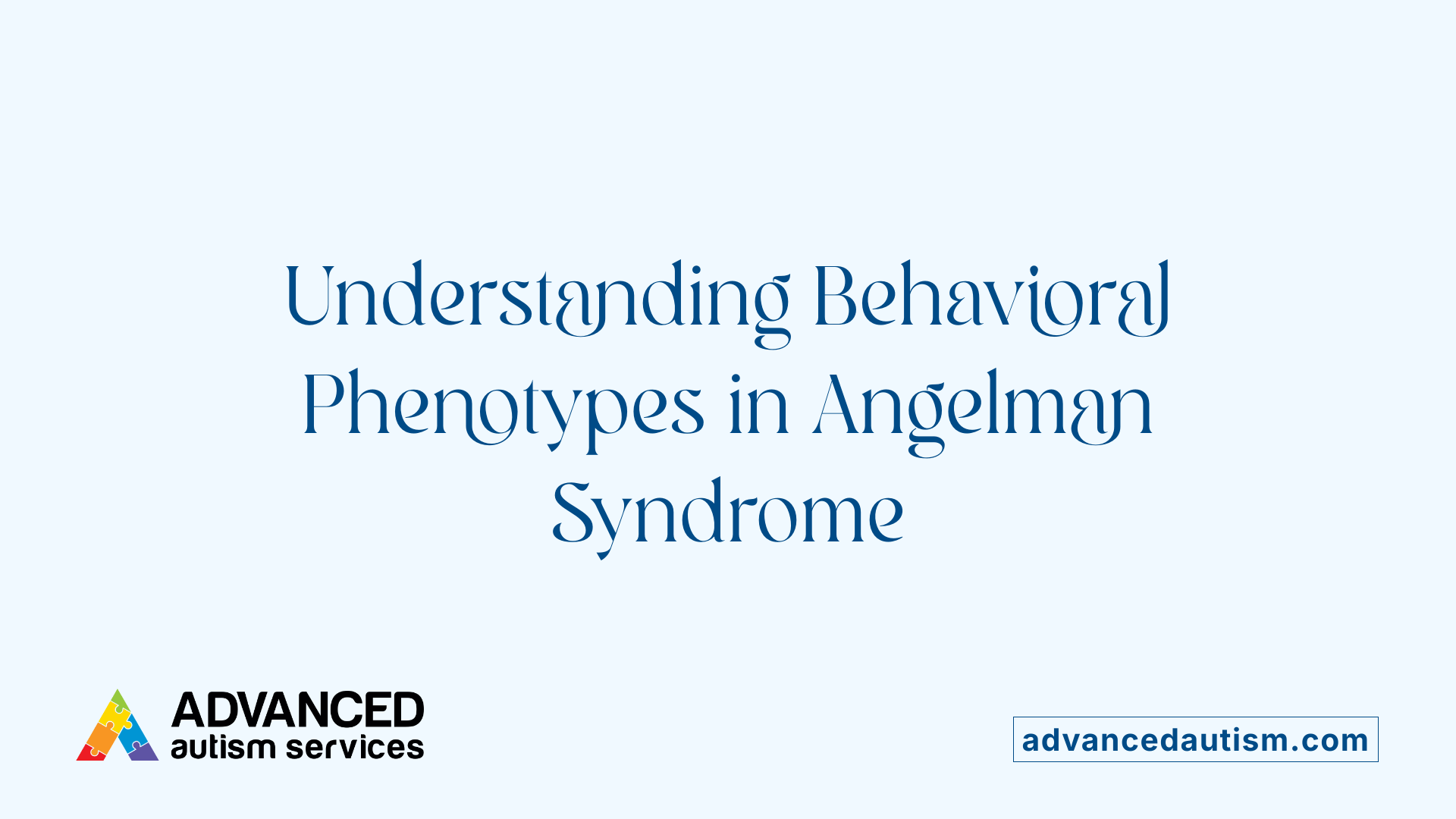
What Behavioral Concerns Are Common in Angelman Syndrome?
Individuals with Angelman syndrome (AS) often exhibit a range of behavioral symptoms that significantly affect daily functioning. These include hyperactivity, aggression, self-injurious actions, repetitive behaviors, and sleep disorders. Such challenges can make caregiving complex and require comprehensive management strategies to improve quality of life for both affected individuals and their families.
How Do Hyperactivity and Aggression Manifest in AS?
Hyperactivity in AS typically presents as elevated activity levels and difficulty in maintaining attention, sometimes coupled with noncompliance. Aggression may be directed toward others or oneself, contributing to self-injury in some cases. Addressing these behaviors through early behavioral interventions and supportive therapies is critical to reducing their intensity and associated risks.
What Repetitive Behaviors Are Observed?
Repetitive behaviors, including stereotypic movements, are distinct in many individuals with AS. These motions or routines can become sustained patterns that interfere with adaptive functioning. Notably, stereotypic behavior has been identified as a strong predictor of parental stress, highlighting the psychosocial impact beyond the individual.
What Sleep Disorders Affect People With Angelman Syndrome?
Sleep disturbances are highly prevalent in children with AS, often manifesting as difficulties falling asleep or maintaining sleep throughout the night. Behavioral therapies have demonstrated positive effects on ameliorating these issues, underscoring the importance of tailored interventions to improve rest and overall wellbeing.
How Does Angelman Syndrome Impact Families?
The behavioral phenotype in AS substantially impacts family quality of life. Parental stress and emotional burden correlate strongly with the severity of behaviors such as hyperactivity and stereotypy. According to assessments like the Family Impact module of the Pediatric Quality of Life Inventory (PedsQL), families face challenges across physical, emotional, social, and cognitive domains. This necessitates both child-focused behavioral training and parent-centered support, including education about the syndrome and coping strategies.
Effective management combines early therapeutic strategies targeting specific behaviors with comprehensive family support, helping to mitigate the profound effects of AS on affected children and their caregivers.
Applied Behavior Analysis (ABA) Therapy: Foundations and Approach
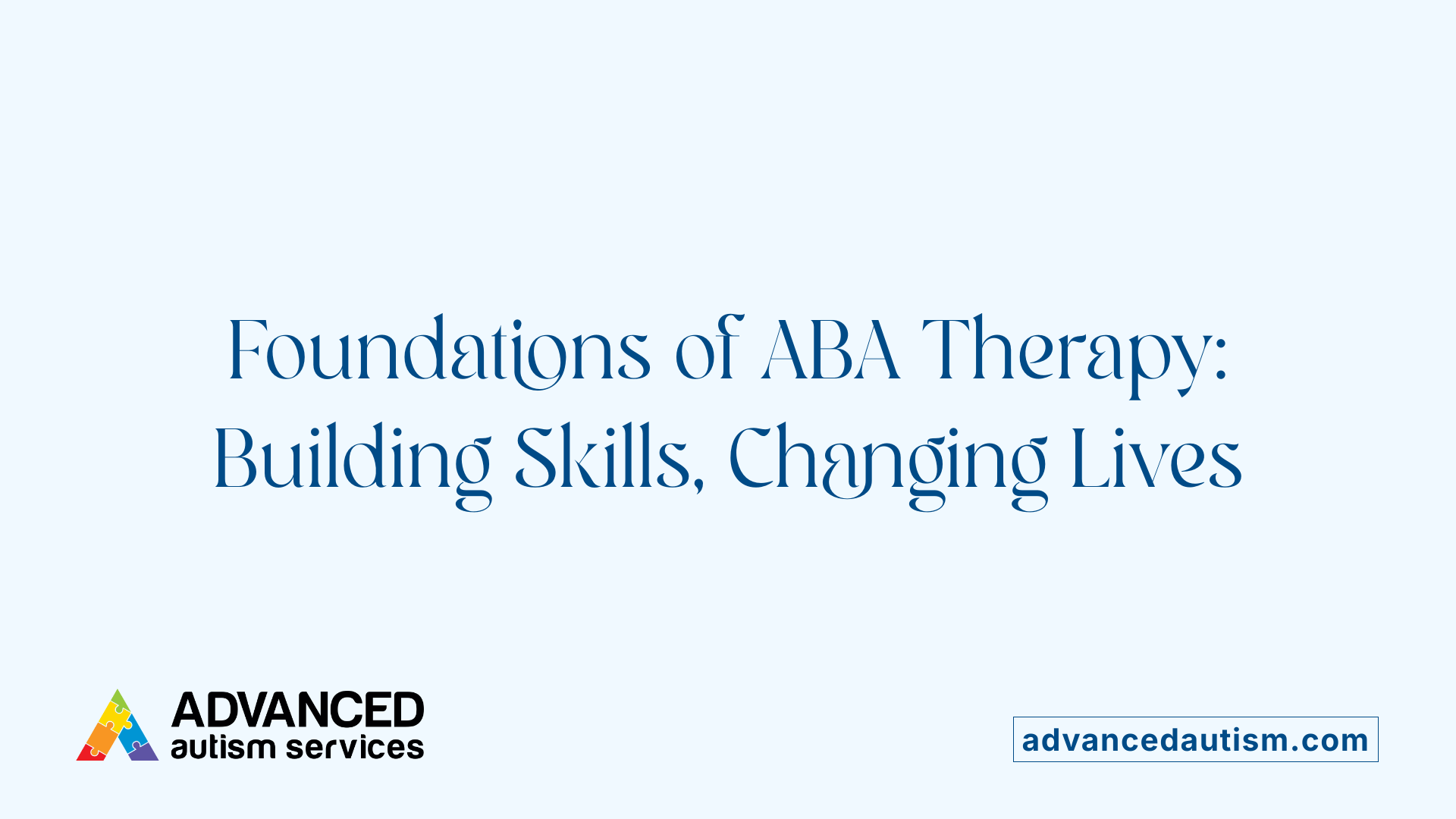
What is Applied Behavior Analysis (ABA) therapy and how does it help individuals with autism?
Applied Behavior Analysis (ABA) therapy is a scientifically grounded intervention that focuses on understanding and modifying behaviors through learning principles. Developed in the 1960s, ABA uses reinforcement strategies to teach new skills and reduce challenging behaviors.
Scientific Basis and Principles of Learning
ABA relies on behavioral science, using positive reinforcement to encourage desirable behaviors while decreasing undesired ones. It applies principles like stimulus control, shaping, and prompting to effectively teach and maintain new skills.
Teaching Communication and Social Skills
ABA programs target core developmental areas such as communication, social interaction, and daily living skills. These are taught through structured, measurable interventions that promote skill acquisition and generalization.
Reducing Problem Behaviors
Strategic ABA methods work to decrease behaviors such as aggression, self-injury, and repetitive actions by identifying their function and implementing tailored behavior plans.
Personalization of Therapy
ABA is highly individualized, focusing on each person's behavioral, social, and adaptive strengths and weaknesses. Licensed professionals, including board certified behavior analysts (BCBAs), psychologists, and clinical social workers, design and implement these personalized treatments.
Techniques like Discrete Trial Training (DTT) and Pivotal Response Treatment (PRT)
Discrete Trial Training breaks skills into small, teachable components with repeated practice and reinforcement. Pivotal Response Treatment targets broad areas such as motivation and responsiveness to multiple cues, making learning more naturalistic.
History and Effectiveness Research
Since its inception in the 1960s, ABA has been extensively studied. Reviews of hundreds of studies demonstrate positive outcomes in cognitive, language, social, and adaptive behaviors for children with autism. Although many studies use single-case designs, the overall evidence supports ABA as an effective, behaviorally grounded therapy.
ABA therapy continues to be a cornerstone recommendation for early and ongoing intervention to help individuals with autism build independence and improve quality of life.
Who Provides ABA Therapy for Individuals with Autism and Angelman Syndrome?
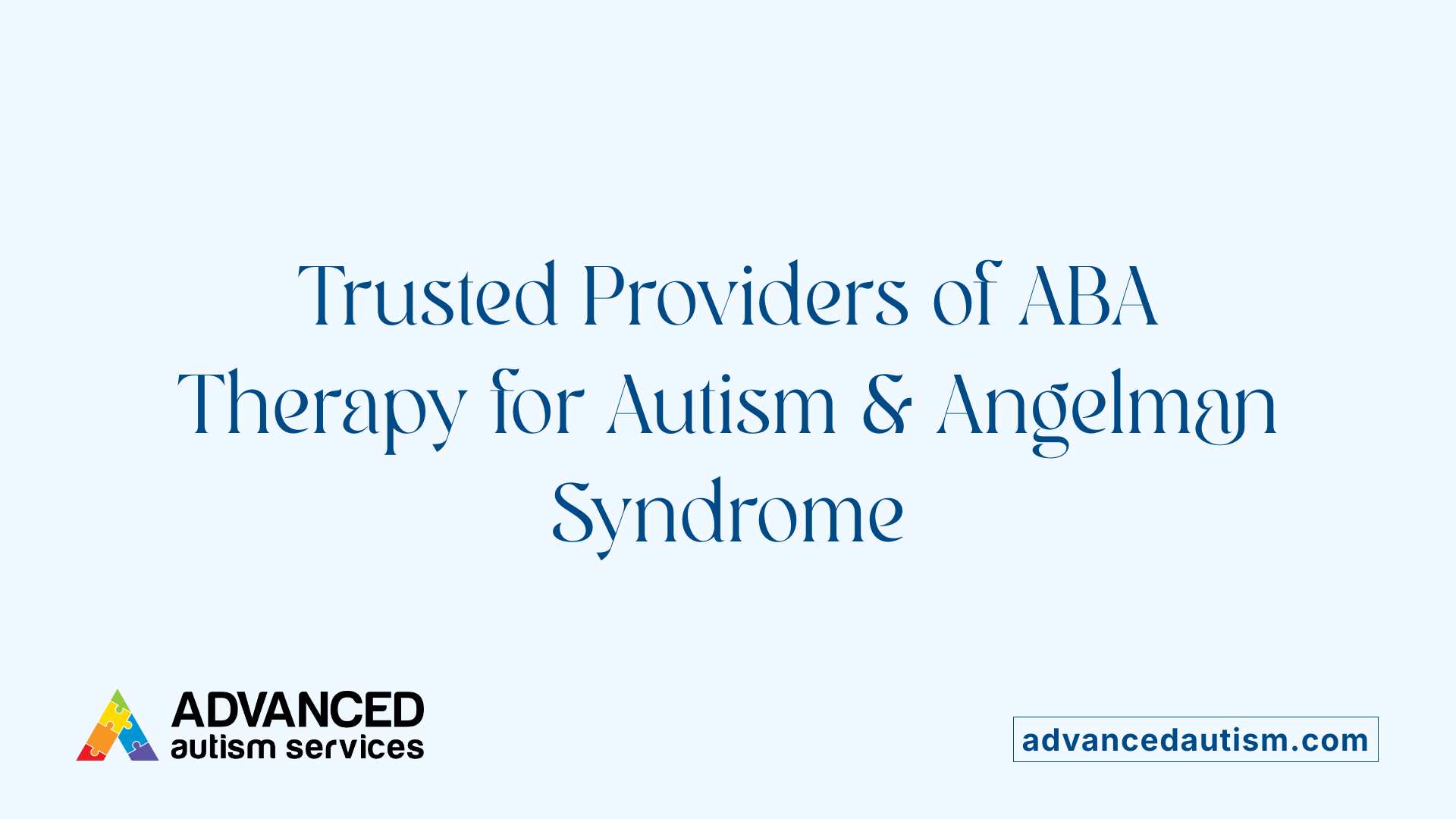
Credentials of ABA Providers
ABA therapy is delivered by trained professionals with specific credentials to ensure effective interventions. The most recognized credentials include Board Certified Behavior Analysts (BCBAs) and Registered Behavior Technicians (RBTs). BCBAs hold advanced certification after extensive training and are responsible for designing and overseeing ABA treatment plans. RBTs typically implement these plans under BCBA supervision, focusing on direct therapy delivery.
Board Certified Behavior Analysts (BCBA)
BCBAs are licensed or certified specialists with expertise in behavior analysis. They construct individualized programs based on thorough assessments and data collection. Their role includes supervising RBTs, evaluating progress, and making necessary adjustments to therapy.
Registered Behavior Technicians (RBT)
RBTs are paraprofessional providers who work directly with patients implementing the behavioral programs crafted by BCBAs. They are trained in behavior intervention techniques and provide the hands-on therapeutic activities.
Licensed Psychologists and Therapists
In addition to BCBA-certified providers, licensed psychologists, licensed clinical social workers, and behavioral therapists with relevant training can deliver ABA or complementary behavioral services. These professionals contribute especially in assessing co-occurring mental health concerns or providing integrated behavioral therapies.
Settings for ABA Delivery
ABA therapy is offered across various settings including specialized clinics, schools, in-home environments, and community locations. This flexibility ensures interventions are consistent and adaptable to the individual's daily environment.
Family Involvement and Training
Family participation is crucial in maximizing ABA therapy outcomes. Providers often offer parent training and coaching to help caregivers reinforce skills and manage behaviors outside therapy sessions.
Specialized Companies and Clinics
Many behavioral health companies and autism service providers employ credentialed ABA staff. These organizations provide structured and evidence-based programs tailored to individuals with autism spectrum disorder (ASD) and conditions like Angelman syndrome.
| Provider Type | Role | Description and Credentials |
|---|---|---|
| Board Certified Behavior Analyst (BCBA) | Develop and oversee ABA programs | Advanced certification; responsible for assessment and treatment plans |
| Registered Behavior Technician (RBT) | Implement ABA interventions | Paraprofessional provider supervised by BCBA |
| Licensed Psychologist/Therapist | Provide behavioral assessments and therapy | Licensed clinicians with training in behavioral therapies |
| Family Members | Reinforce skills and strategies at home | Trained and coached by providers to support ongoing interventions |
This multi-disciplinary approach helps ensure that ABA therapy is effective, personalized, and integrated into the individual’s daily life, benefiting those with autism and Angelman syndrome alike.
The Role of Behavioral Therapy in Managing Angelman Syndrome Symptoms
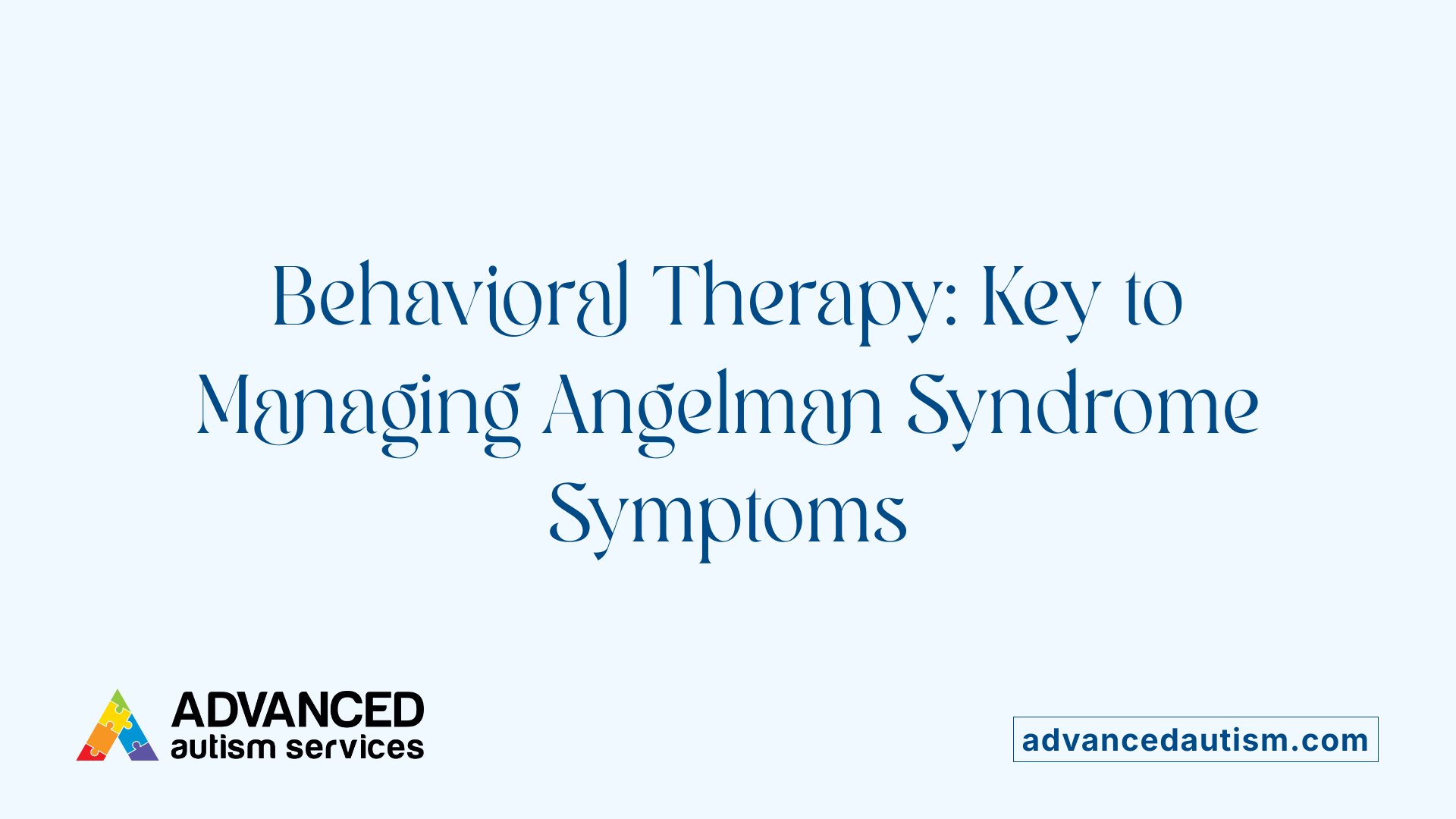
Why is behavioral therapy important in Angelman Syndrome?
Behavioral therapy is a fundamental approach for managing Angelman Syndrome (AS), particularly its mental health and behavioral challenges. AS manifests with symptoms such as hyperactivity, aggression, self-injury, repetitive behaviors, and sleep disorders, all of which significantly affect both individuals and their families. Early and ongoing behavioral therapy helps tailor interventions to an individual's specific behavioral, social, and adaptive needs, improving quality of life and supporting developmental progress.
How can behavioral therapy address aggression and sleep disorders in AS?
Aggression and sleep disturbances are common and challenging in AS. Behavioral therapies, including applied behavior analysis (ABA) and cognitive-behavioral interventions, focus on reducing harmful behaviors and establishing healthy sleep routines. Addressing these concerns through structured, science-based behavioral plans helps to decrease irritability and improve sleep quality. Such improvements directly benefit both the individuals with AS and their caregivers by reducing stress and promoting a more stable daily routine.
Why is early identification and intervention crucial?
Early identification of AS is critical, as initiating behavioral therapy from as young as 1–3 years old leads to better outcomes. Early intervention allows therapists to develop targeted treatments before behavioral problems intensify, enabling children to build adaptive skills from a young age. Continuity of care is emphasized, recognizing that behavioral therapy is often a lifelong necessity for managing complex syndromic symptoms.
What role do cognitive-behavioral therapies play?
Cognitive-behavioral therapies (CBT) are tailored to help manage mental health challenges within AS by changing thought patterns and behaviors linked to aggression, anxiety, and sleep disturbances. These therapies support emotional regulation and develop coping mechanisms, which are vital for improving mental health outcomes in individuals with AS.
How are behavioral treatments tailored for individuals with AS?
Interventions are individualized, targeting specific behavioral phenotypes and personal strengths and weaknesses. Licensed professionals such as psychologists, licensed clinical social workers, and board-certified behavior analysts (BCBAs) use tools like the Aberrant Behaviour Checklist to tailor therapy focusing on issues like hyperactivity, stereotypic behaviors, and inappropriate speech. Both child-focused behavioral training and parent-centered education are recommended to maximize effectiveness.
How does behavioral therapy support mental health in AS?
Behavioral therapy not only addresses visible behavioral symptoms but also plays a vital role in supporting overall mental health. By mitigating symptoms such as aggression and poor sleep, it helps reduce anxiety and frustration. Combined with parental education and psychological support, these therapies diminish caregiver stress and enhance family dynamics, fostering a healthier environment for individuals with AS.
Interventions Targeting Sleep and Hyperactivity in AS
How prevalent are sleep problems in Angelman syndrome?
Sleep disturbances are common in children with Angelman syndrome (AS), significantly affecting their daily functioning and well-being. These difficulties are recognized as a hallmark behavioral challenge within the AS community.
What behavioral interventions help manage sleep disturbances in AS?
Behavioral therapies have demonstrated positive effects on sleep issues in AS. Interventions often include establishing consistent bedtime routines, modifying environmental factors, and using cognitive-behavioral techniques tailored to the child's needs. This non-pharmacological approach helps improve sleep quality and duration.
How can hyperactivity and noncompliance be managed?
Hyperactivity, including noncompliant behaviors, is a frequent concern in AS that impacts both the individual and their caregivers. Targeted behavioral training is recommended to address these symptoms. Structured interventions focus on reducing irritability, repetitive behaviors, and promoting compliance through positive reinforcement and skill-building.
What roles do behavioral training and drug therapy play?
Combining behavioral training with drug therapy can be an effective strategy for controlling hyperactive and aggressive behaviors in AS. Behavioral training empowers caregivers with coping strategies and tailored techniques, while drug therapy may be prescribed to alleviate severe symptoms when necessary.
How do these behavioral challenges impact family quality of life?
Behavioral problems such as sleep disturbances and hyperactivity correlate strongly with increased parental stress and reduced family quality of life. Assessments like the Family Impact module of the Pediatric Quality of Life Inventory (PedsQL) highlight the emotional and social burdens placed on families. Early and individualized behavioral interventions not only improve child outcomes but also significantly alleviate caregiver stress, enhancing overall family functioning.
Behavioral Phenotypes and Their Impact on Families of Individuals with AS
Stereotypic Behaviors and Other Challenging Symptoms
Individuals with Angelman syndrome (AS) often exhibit distinct behavioral phenotypes, including stereotypic behaviors characterized by repetitive motor movements or rituals. These behaviors, along with irritability, agitation, hyperactivity, and noncompliance, present significant challenges for day-to-day functioning.
Parental Stress and Quality of Life
These behavioral symptoms profoundly impact parental stress and overall family quality of life. Studies have identified stereotypic behavior as the strongest predictor of heightened parental burden, often causing emotional, social, and practical challenges for caregivers.
Measuring Family Impact with PedsQL
To assess this impact, researchers utilize the Family Impact Module of the Pediatric Quality of Life Inventory (PedsQL). This tool evaluates various domains such as physical and emotional functioning, communication, daily activities, and family relationships, providing a comprehensive picture of how behavioral issues affect families.
Importance of Family-Centered Approaches
Given these effects, family-centered approaches to intervention are crucial. Combining child-focused behavioral training with education and coping strategies for parents can alleviate stress and improve management of behavioral challenges. Tailored therapies that address specific phenotypes enhance both child outcomes and family well-being, highlighting the importance of supportive, comprehensive care in AS.
Evidence Supporting ABA and Behavioral Interventions
Review of ABA Studies
Applied Behavior Analysis (ABA) is a widely recognized and evidence-based behavioral intervention, particularly for autism spectrum disorder (ASD), but its principles are also applicable to conditions like Angelman syndrome. A comprehensive review analyzing 770 articles on ABA interventions revealed numerous positive outcomes across multiple developmental domains.
Positive Cognitive and Language Outcomes
Many studies report significant improvements in cognitive development and language skills following ABA therapy. These gains contribute to better overall functioning and support enhanced learning capacities in children undergoing the intervention.
Social and Communication Improvements
ABA interventions also lead to meaningful enhancements in social skills and communication abilities. These improvements help individuals better engage with their environment, facilitating more effective interactions and relationships.
Reduction in Problem Behaviors
A notable benefit of ABA includes the reduction of problem behaviors such as aggression, self-injury, and repetitive behaviors. These behavior changes can improve the quality of life for both the individuals receiving therapy and their caregivers.
Comprehensive ABA Models: EIBI, ESDM, LEAP
Several comprehensive ABA-based programs have been developed and extensively studied, including Early Intensive Behavioral Intervention (EIBI), Early Start Denver Model (ESDM), and Learning Experiences and Alternative Program for Preschoolers and Their Parents (LEAP). These models target various developmental areas and are adapted to different age groups, offering structured approaches to intervention.
Research Methodologies and Limitations
Much of the research relies on single-case experimental designs (SCEDs), which are effective for individualized assessment but limit generalizability. There is a recognized need for more large-scale, randomized controlled trials (RCTs) to strengthen the evidence base. Other limitations include small sample sizes, variable methods, inconsistent definitions of ABA, and limited long-term follow-up and quality of life measurements.
Challenges in Accessing and Implementing Behavioral Therapies
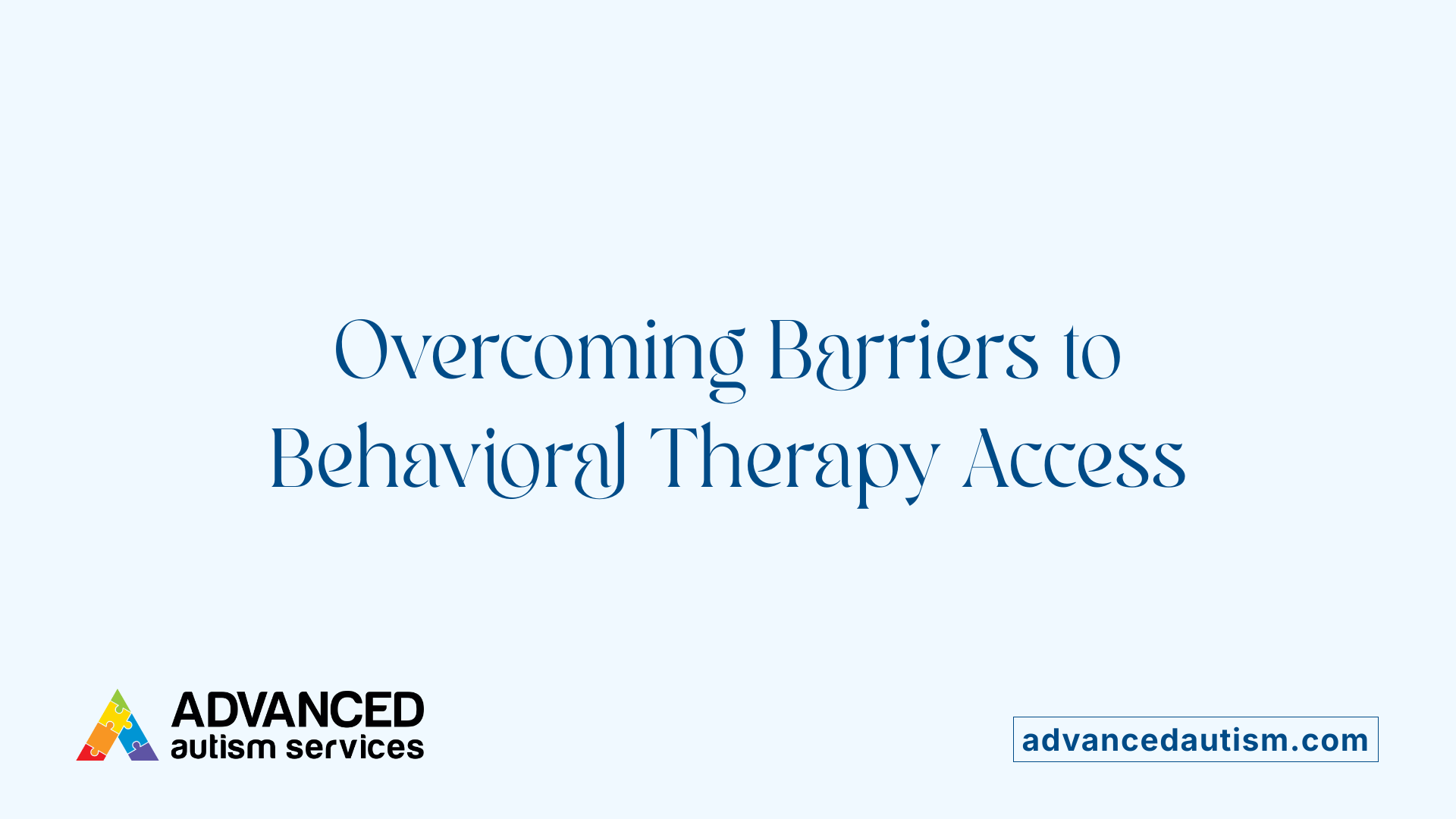
Limited Access to ABA and Behavioral Therapy
Access to Applied Behavior Analysis (ABA) and other behavioral therapies remains a significant challenge for many individuals with Angelman syndrome (AS). Despite its proven effectiveness, availability is often constrained by factors such as geographic location, funding limitations, and shortages of qualified professionals like board certified behavior analysts (BCBAs).
Eligibility Criteria Constraints
In several regions, eligibility for behavioral therapy services is contingent on a dual diagnosis, such as co-occurring autism spectrum disorder (ASD). This requirement restricts therapy access for some individuals with AS who do not meet the additional diagnostic criteria, delaying or preventing early intervention.
Need for Early Intervention
Early identification and intervention, ideally starting between 1 to 3 years of age, are critical for maximizing therapeutic outcomes in AS. Delays caused by restricted access or eligibility hurdles can reduce the long-term benefits of behavioral therapies in managing behavioral and mental health concerns.
Variability Across Regions and States
Access to behavioral treatment varies widely across states and regions, reflecting differences in healthcare policies, insurance coverage, and availability of specialized providers. This patchwork landscape contributes to unequal treatment opportunities and inconsistent support for families affected by AS.
Importance of Equity in Treatment Availability
Ensuring equitable access to behavioral therapies is essential to address disparities and improve quality of life for individuals with AS and their families. Efforts to streamline eligibility, increase service providers, and promote early intervention can help bridge current gaps that impact therapeutic success and caregiver well-being.
Tailoring Behavioral Interventions to Individual Needs in AS
Science-Based, Individualized Assessment
Behavioral therapy for individuals with Angelman syndrome (AS) involves science-based, targeted interventions tailored to each person's unique behavioral, social, and adaptive strengths and weaknesses. Licensed mental health professionals such as psychologists, licensed clinical social workers, or board-certified behavior analysts (BCBA) conduct thorough assessments to identify specific needs, enabling the design of individualized programs.
Addressing Specific Behavioral and Social Strengths
Interventions focus on challenging symptoms common in AS, including hyperactivity, aggression, self-injury, repetitive behaviors, and sleep difficulties. Therapy targets these behaviors while leveraging social and adaptive strengths to foster improvements in communication, daily living skills, and emotional regulation.
Parental Education and Coping Strategies
An important component of therapy includes parent-centered approaches that provide education about AS's characteristics, empowering caregivers with effective strategies to manage behaviors and reduce stress. This education helps improve family dynamics and supports parental emotional well-being.
Child-Focused and Parent-Centered Therapy Approaches
Therapies combine child-focused training—such as applied behavior analysis (ABA) starting from ages 1 to 3 years and continuing throughout life—with parent-focused support. This dual approach helps address behavioral challenges directly in children while enhancing caregiver capacity to support ongoing development.
Importance of Continuous Support
Continued behavioral therapy and periodic reassessment ensure that interventions evolve alongside the individual’s needs. Sustained support aids in managing emerging challenges and maintaining gains in behavior, sleep, and social functioning throughout life.
Future Outlook: Integrating Gene Therapy and Behavioral Treatments
How could gene therapy complement behavioral therapy in Angelman syndrome?
The emerging gene therapy at UC Davis offers a promising complement to established behavioral therapies. By delivering a functional UBE3A gene through modified bone marrow stem cells, this gene therapy aims to correct the underlying genetic defect responsible for Angelman syndrome. When combined with behavioral therapies like Applied Behavior Analysis (ABA), which address symptoms such as aggression, hyperactivity, and sleep disorders, an integrated treatment model could more comprehensively address both the biological and behavioral challenges of the condition.
What is the significance of a translational approach in developing treatments?
The research team’s translational approach—bridging neuroscience, stem cell therapy, immunology, and virology—enhances the potential for gene therapy to progress from laboratory studies to clinical application. This multidisciplinary collaboration ensures that therapies are designed both with biological precision and practical considerations for patient care, including safety and long-term efficacy.
Is symptom reversal a realistic hope with current gene therapy research?
Studies in mouse models have challenged previous beliefs by demonstrating that the gene therapy can reverse Angelman syndrome symptoms even in adult mice. This breakthrough suggests that symptom reversal, not just early prevention, may be possible, marking a paradigm shift in treating neurodevelopmental disorders traditionally considered irreversible after early childhood.
How might gene therapy expand to related neurodevelopmental disorders?
Given the shared biological pathways in conditions like SYNGAP1 syndrome, the gene therapy platform developed for Angelman syndrome could potentially be adapted to treat other neurodevelopmental disorders. This opens avenues for broader therapeutic applications beyond a single diagnosis, maximizing the impact of this advancing technology.
Why is multidisciplinary research essential in this field?
Tackling complex disorders like Angelman syndrome requires expertise from multiple scientific and clinical disciplines. Neuroscience informs understanding of brain function and dysfunction; stem cell therapy offers delivery mechanisms; immunology ensures safety and compatibility; and behavioral sciences guide symptom management. Such integrated research accelerates innovation and optimizes treatments for patients’ diverse needs.
Towards Holistic Management of Angelman Syndrome
The evolving landscape of Angelman syndrome treatment reflects a promising integration of advanced gene therapies and comprehensive behavioral interventions. While gene therapy efforts focus on addressing the underlying genetic cause with innovative stem cell techniques, behavioral therapies like Applied Behavior Analysis remain critical in managing the complex behavioral and mental health challenges faced by individuals with AS and their families. Continued research, early intervention, and equitable access to these therapies offer hope for improved quality of life and functional outcomes. Ultimately, a multidisciplinary, individualized approach is essential to meeting the unique needs of those affected by Angelman syndrome.
References
- UC Davis scientists pioneer stem cell gene therapy for ...
- Current and emerging treatment options for Angelman ...
- Behavioral Therapy for Angelman Syndrome
- Applied Behavior Analysis in Children and Youth with Autism ...
- Significance of Behavioural Problems on Family Impact in ...
- Current and emerging treatment options for Angelman ...
- Applied Behavior Analysis (ABA)
- Applied Behavior Analysis (ABA)
- Treatment and Intervention for Autism Spectrum Disorder



